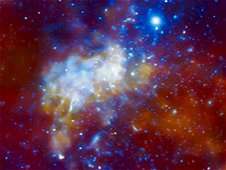Asymmetric structure in the supermassive black hole at the galaxy's center

The supermassive black hole candidate at the center of our Galaxy (associated with the radio source Sgr A*) is a prime candidate for studying the physical phenomena associated with accretion on to a supermassive black hole. Sgr A* is thought to accrete at an extremely low rate; analogous situations in X-ray binary stars suggest that a jet may be present, making it challenging to formulate a fully self-consistent model that simultaneously explains its spectrum, its variability, its size and its shape. Because Sgr A* is by far the closest supermassive black hole, its expected angular size (the shadow cast from its event horizon) is the largest of any known black hole candidate, making it a prime target for studies using very long baseline interferometry at mm wavelengths, which are capable of reaching spatial resolutions comparable to the expected shadow size.
CfA astronomer Shep Doeleman was a member of a team of twenty-two astronomers that used a combination of three widely separated millimeter telescope facilities, the Very Long Baseline Array, the Robert C. Byrd Green Bank Telescope, and the Large Millimeter Telescope Alfonso Serrano, to try to image the Sgr A* shadow. Their observations were taken in May of 2015 over the course of one evening, and the data from all the telescopes were analyzed to ascertain the geometry.
The scientists found some evidence for an asymmetric shape – a tiny extension that seems to protrude only a few AU from the central source (one astronomical unit is the average distance of the Earth from the Sun). This preliminary result could be due to scattering of the radiation by interstellar material, but it might also be associated with the black hole. Other observers have reported spotting some similar asymmetries, but the picture remains uncertain. The new result is a step forward, however, and future observations will try to refine and extend the current conclusions.
More information: Christiaan D. Brinkerink et al. Asymmetric structure in Sgr A* at 3 mm from closure phase measurements with VLBA, GBT and LMT, Monthly Notices of the Royal Astronomical Society (2016). DOI: 10.1093/mnras/stw1743
Journal information: Monthly Notices of the Royal Astronomical Society
Provided by Harvard-Smithsonian Center for Astrophysics




















